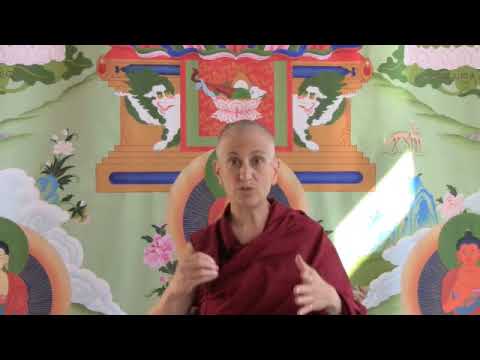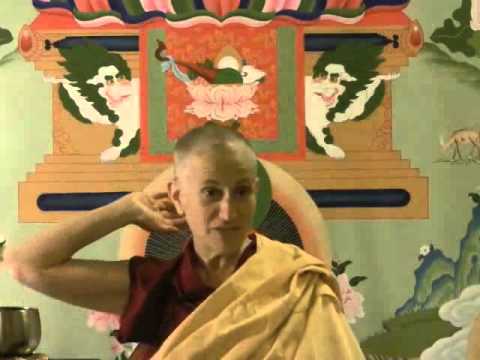The Buddha’s first teaching
Stages of the Path #86: The Four Noble Truths
Part of a series of Bodhisattva's Breakfast Corner talks on the Stages of the Path (or Lamrim) as described in the Guru Puja text by Panchen Lama I Lobsang Chokyi Gyaltsen.
- The meditation on the four noble truths
- The four noble truths as the framework
- The importance of understanding the four truths in depth
We just finished another verse. We finished the third verse,
Aghast at the searing blaze of suffering in the lower realms we take heartfelt refuge in the Three Jewels. Inspire us to eagerly endeavor to practice the means for abandoning negativities and accumulating virtues.” We just finished that verse which contained the topics of the potential for an unfortunate rebirth, taking refuge, and then karma as a means to avoid an unfortunate rebirth.
Now we’ll move on to the next verse, which reads:
Violently tossed amidst waves of disturbing attitudes and karma, [Now I would translate it as “afflictions and karma.”] plagued by the hoards of the sea monsters, the three kinds of suffering, we seek your inspiration to develop and intense longing to be free from this monstrous ocean of boundless and vicious existence.
This is the meditation on the first two of the four noble truths. The subsequent verse is the meditation on the last two of the four noble truths.
Let’s just talk for a minute about the four noble truths before we go into the details here.
The Buddha’s first teaching where he really gave the perspective of what the path is all about and what we’re aiming for is the four noble truths. The first two truths are to be abandoned (that’s dukkha and the causes of dukkha), and the last two truths are to be attained (in other words the cessation of dukkha and its causes and the path to that cessation).
It’s important to have a general understanding of these four because this is the framework within which everything happens. And it’s important to understand each of the four in depth and not just some kind of fuzzy understanding. As I always tell people, we hear about the first two, dukkha (which is often translated as “suffering” but it’s not a good translation). We hear about that and its causes and we go, “Yuck! I don’t want to hear about that. I want to hear about light and love and bliss and flashy colors and ecstasy and Kundalini going here and there…. I want some jazzy shmazzy experience.” [laughter] Don’t you want a jazzy-shmazzy experience? We all went to Kopan in the early days, we were all kind of on various kinds of …. other substances looking for some kind of jazzy-shmazzy experience, and, you know…. [laughter] You get all sorts of highs when you take drugs, don’t you? And then you come down. Don’t you? So that technique just doesn’t work.
The path isn’t about having these kinds of wowie-kazowie experiences. It’s about actually transforming our mind. And it’s about actually looking, being able to look, very clearly at the situation we’re in, and very clearly at how our mind is involved in creating the situation. And really understanding that it’s not about changing locations. It’s about dealing with the mind and changing the mind. That’s the real key thing the Buddha’s trying to get across to us is that we are the creator of our experience, because we create our karma AND we also create the interpretation of the present situation that we have right now.
Really understanding how this produces dukkha, how these mental afflictions cause that dukkha, and then that it’s possible to eliminate them, and there’s a path to doing so. That the path depends on us, it doesn’t depend on somebody else. It doesn’t depend on a creator god, it doesn’t depend on our spiritual teacher saving us or something like that. It depends on our hearing the teachings, putting them into practice, and transforming our own mind.
We’ll go into more depth in the four noble truths in the upcoming days.
Venerable Thubten Chodron
Venerable Chodron emphasizes the practical application of Buddha’s teachings in our daily lives and is especially skilled at explaining them in ways easily understood and practiced by Westerners. She is well known for her warm, humorous, and lucid teachings. She was ordained as a Buddhist nun in 1977 by Kyabje Ling Rinpoche in Dharamsala, India, and in 1986 she received bhikshuni (full) ordination in Taiwan. Read her full bio.


